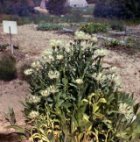 |
QUICK SEARCH
MO PROJECTS:
Africa
Asia/Pacific
Mesoamerica
North America
South America
General Taxonomy
Photo Essays
Training in Latin
America
MO RESEARCH:
Wm. L. Brown Center
Bryology
GIS
Graduate Studies
Research Experiences
for Undergraduates
Imaging Lab
Library
MBG Press
Publications
Climate Change
Catalog Fossil Plants
MO DATABASES:
W³MOST
Image Index
Rare Books
Angiosperm
Phylogeny
Res Botanica
All Databases
INFORMATION:
What's New?
People at MO
Visitor's Guide
Herbarium
Jobs & Fellowships
Symposium
Research Links
Site Map
Search
ORNAMENTAL PLANTS OF HORTICULTURE VALUESelection of perennials
About 450 species (in the broad sense) distributed primarily in Europe and southwestern Asia; 178 species in FSU. Only a few make good garden plants. C. bella Trautv., C. dealbata Willd., C. hypoleuca DC., C. montana L. and C. scabiosa L. are well-known. Several ornamental species have not so far been used in gardening, among them are C. barbei (Albov) Sosn., C. fischeri Schlecht., C. ruthenica Lam. and C. woronowii Bornm. ex Sosn. C. barbeyi (Albov) Sosn. Caucasus (western Transcaucasus). In low mountain zone on cliffs and on gravelly soil. Stem 30-40 cm. Basal leaves in rosette, lyrate-pinnatifide, ovate-oblong, 30 cm long, green above, white-tomentose beneath. Stem leaves numerous, small, ovate. Flower heads almost globose, 2.5-3.0 cm diam. Flowers pink. V - early spring (rosette of leaves overwinters). Fl - May. Fr - July (in the wild). P - by seed. Requires a sunny position. Z 6 (5). New. C. fischeri Schltr.
Taprooted plant 40-70 cm with greyish pubescence. Basal and lower
stem leaves petiolate, upper sessile, lanceolate, oblong lanceolate or
elongate oblong-lanceolate. Middle stem leaves 15-25 cm x 2-5 cm.
Head 9 cm diam. Central and marginal flowers cream-white to pink-lilac.
V - May to October in St. Petersburg, April to October in the wild.
Fl - June-July, for one month. Fr - August. P -by seed or by division
of mature specimens. Does well in full sun. Z 4. New.
C. woronowii Bornm. ex Sosn. Caucasus (western Transcaucasus) and Asia Minor. On dry rocky soil and talus. Rhizome vertical, thick with numerous long roots. Stem 10-25 cm, unbranched or corymbosely branched. Leaves densely grey-tomentose, basal about 20 cm long, lyrate-pinnatifid, upper segment larger than the others, stem leaves simple, dentate or entire. Flower heads in terminal clusters of 2-6. Involucre cylindrical, 15 mm long, involucral bracts with pectinate appendages, ray-like. Flowers purple. V - early spring to late autumn. Fl - June-July for one month. Fr - August. Good for dry sunny places, very drought-resistant. Z 5. New. Also of horticultural value: C. mollis Waldst. et Kit. from the forests of the Carpathians and Eastern Europe. Stem 40 cm. Leaves silver-green, flowers bright blue. Cold and shade resistant. Grow in any soil. C. ruthenica Lam. is of wide disribution. It occurs in in southern Russia, Caucasus (southern Transcaucasus), Central Asia (eastern regions) and in southestern Europe. Stem 1.0-1.5 m, branched, flowers pale yellow. Drought and cold resistant plant. |
|||
| SELECTION OF PERENNIALS |
© 1995-2025 Missouri Botanical Garden, All Rights Reserved
4344 Shaw Blvd.
St. Louis, MO 63110
(314) 577-5100
Technical Support
